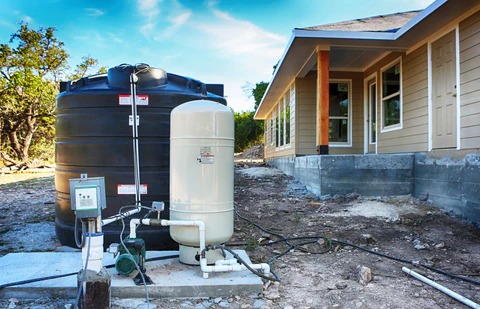Water storage is one of the most critical aspects of designing any property, be it a luxurious villa or a bustling commercial unit. Adequate and well-maintained water storage not only ensures uninterrupted supply but also safeguards the quality of water, preventing costly and inconvenient problems.
Yet, many property owners make mistakes in the planning, purchasing, and maintenance stages, leading to long-term issues.
This blog will explore the most common water storage mistakes and how to avoid them. Whether you’re in the early stages of construction or looking to upgrade, these insights will help you make informed decisions.
Mistake 1: Choosing the Wrong Tank Material
Your choice of water tank material can make or break your system’s longevity and effectiveness. Not all materials are created equal, and selecting the wrong one could put your investment at risk.
Popular Tank Materials and Their Pros/Cons:
- Plastic (Polyethylene or PVC):
-
- Pros: Lightweight, affordable, and resistant to rust and corrosion.
-
- Cons: Susceptible to UV damage over prolonged exposure and may not withstand extreme temperatures.
- Stainless Steel:
-
- Pros: Durable, rust-resistant, and great for maintaining water purity.
-
- Cons: Expensive and prone to dents or scratches.
- Concrete:
-
- Pros: Extremely durable, customizable size options, and good for underground storage.
-
- Cons: Prone to microbial growth if not sealed properly and difficult to modify or move.
- Fiberglass:
-
- Pros: Corrosion-resistant, durable, and ideal for long-term storage.
-
- Cons: Can be expensive and complicated to install.
Pro Tip: Evaluate factors like climate, budget, and your water usage to determine the material that best suits your property. For example, stainless steel might be perfect for villas while fiberglass tanks might better fit commercial facilities.
Mistake 2: Incorrect Tank Sizing
One of the most costly mistakes is underestimating or overestimating your water storage needs. A tank that’s too small might leave you running out of water, while an oversized tank could drive up unnecessary costs.
How to Calculate Water Storage Needs:
- Determine Daily Usage: Assess household or commercial water consumption. For example, a villa housing a family of four typically requires 150-200 gallons per day, while commercial units may need far more depending on operations.
- Factor in Emergency Storage: Consider additional storage for emergencies like power outages or maintenance delays.
- Account for Future Needs: If the property might expand or usage intensifies over time, plan ahead to avoid costly upgrades later.
Tools like water usage calculators can take the guesswork out of sizing. Consulting with a professional supplier can also ensure you select an appropriately sized tank.
Mistake 3: Poor Installation Practices
Even the best tank won’t perform well if installed incorrectly. Poor installation practices compromise water quality, lead to rapid wear and tear, and even cause structural damage.
Key Considerations for Proper Tank Installation:
- Secure Foundations: Place your tank on a reinforced concrete base (or any suitable flat surface) to prevent tipping and damage.
- Ensure Proper Ventilation: Ventilation keeps pressure under control and prevents damage due to airlocks.
- Avoid Direct Sunlight: For above-ground tanks, install them in shaded areas or use a UV-resistant covering to prolong the life of materials like plastic.
- Inspect Connections: Get pipes, lids, valves, and outlets securely installed to avoid leaks or contamination risks.
Working with skilled installers ensures that these fundamentals are covered, saving you the headache of frequent repairs.
Mistake 4: Neglecting Regular Maintenance
Too often, water tanks are treated as “set-it-and-forget-it” systems. However, without regular cleaning and maintenance, your tank becomes a breeding ground for algae, bacteria, and corrosion.
Key Maintenance Tasks:
- Cleaning: Schedule tank cleaning at least twice a year to remove sediment buildup.
- Inspect for Cracks or Leaks: Small cracks in your tank can escalate into major issues if left unchecked.
- Test Water Quality: Conduct periodic water quality tests to ensure it’s safe for consumption or usage.
- Replace Fittings and Seals: Over time, fittings may deteriorate. Replace them regularly to prevent leaks.
Maintenance doesn’t just protect your tank, but also the health of those consuming the water.
Mistake 5: Ignoring Local Regulations
Every region has its own set of laws governing water storage systems, including permitting, installation requirements, and safety standards. Ignoring these regulations can result in hefty fines, delays, or worse, legal action.
Common Regulatory Requirements to Be Aware Of:
- Permits for Large Tanks: Commercial units will nearly always require permits for tanks exceeding a specified volume.
- Proper Drainage Setup: Your water storage system must include provisions for overflow and drainage water disposal to avoid property flooding or legal disputes.
- Material Compliance: Some regions mandate tanks be made of certain materials that meet health and safety guidelines.
- Backflow Prevention: Ensuring the system has backflow prevention helps avoid contamination between drinking water and alternative sources.
Pro Tip: Consult with local authorities or a compliance expert during the planning and installation phase to stay on the right side of the law.
Plan Ahead for a Stress-Free Water Storage Experience
Water storage is a foundational aspect of any property, but cutting corners can cost more in the long run. By avoiding these common mistakes, you can ensure efficient, reliable, and long-lasting water storage for your villa or commercial unit.
At the end of the day, partnering with professionals can make all the difference. They bring expertise, experience, and real-world insights that simplify the decision-making process. From choosing the right tank material to navigating compliance requirements, their guidance ensures peace of mind.
If you’re still unsure where to begin, consult with our dedicated team of water storage experts to make your project a success.







